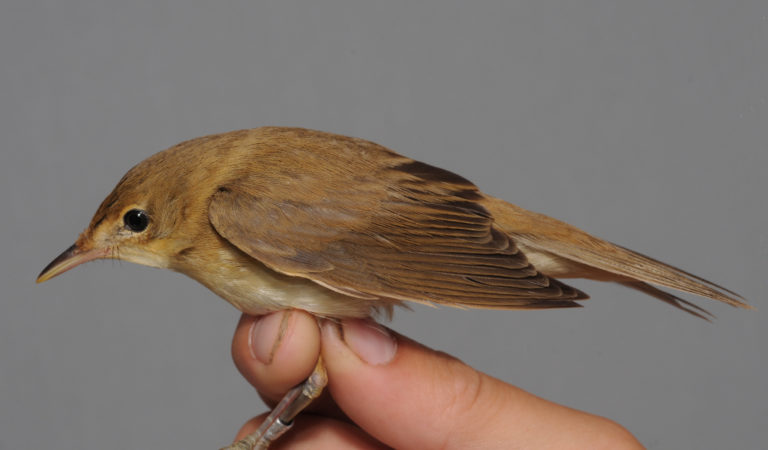

Marsh Warbler & European Reed Warbler
ID – BEST CRITERIA:
Identification of these species is a well known subject to many European ringers. Some individuals are readily identified while others (especially young birds in autumn) are difficult indeed. Always base the id on as many characters as possible. The quick-guide given here is far from complete, and more help is found in e.g. Svensson (1992) and Kennerly & Pearson (2010).
A. palustris / Marsh Warbler
Plumage:
Soft-parts:
Wing-formula (according to Svensson 1992):
A. scirpaceus / European Reed Warbler
Plumage:
Soft-parts:
Wing-formula (according to Svensson 1992):

A. palustris, 1cy August. In 1cy the difference in colour may be less clear than between 2cy+ birds, and some birds are truely difficult to identify. Note the subtly paler straw colour above, and (less easily seen here) paler and cleaner flanks. Still, biometrics are crucial in the process. [CP46848]

A. palustris (lower) and scirpaceus (upper), 2cy+ May. Note 1) the rufous rump in the scirpaceus, and 2) the still present fine whitish tips to PP in the palustris. The appearant difference in tail length is only due to the lowered position angle in the palustris-tail. [CS02495 and CS02496]

A. palustris (lower) and scirpaceus (upper), mixed ages and seasons. The leg colour is generally darker in scirpaceus, but extensive variation (partly due to the age of the bird) makes the character dangerous to use. The colour of the claws gives better guidance: In scirpaceus dark above, clearly contrasting to the underside, while palustris are paler above, less contrasting to the underside. Note, however, that individual variation makes a few birds more difficult - for example the shown upper-right scirpaceus with pale claws. Note also the tendancy for palustris to show slightly thicker legs.
More Acrocephalus palustris:
Ageing autumn
Ageing spring
Moult
More Acrocephalus scirpaceus:
Ageing autumn
Ageing spring
Moult
Ringers’ DigiGuide is sponsored by:
Hemsidan producerad i samarbete med
BirdLife Sverige